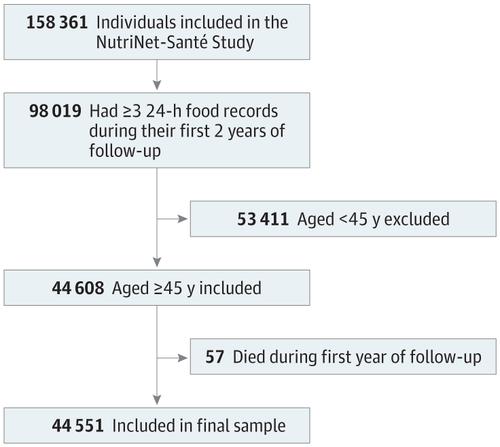当前位置:
X-MOL 学术
›
JAMA Intern. Med.
›
论文详情
Our official English website, www.x-mol.net, welcomes your feedback! (Note: you will need to create a separate account there.)
Association Between Ultraprocessed Food Consumption and Risk of Mortality Among Middle-aged Adults in France
JAMA Internal Medicine ( IF 22.5 ) Pub Date : 2019-04-01 , DOI: 10.1001/jamainternmed.2018.7289 Laure Schnabel 1, 2 , Emmanuelle Kesse-Guyot 1 , Benjamin Allès 1 , Mathilde Touvier 1 , Bernard Srour 1 , Serge Hercberg 1, 2 , Camille Buscail 1, 2 , Chantal Julia 1, 2
JAMA Internal Medicine ( IF 22.5 ) Pub Date : 2019-04-01 , DOI: 10.1001/jamainternmed.2018.7289 Laure Schnabel 1, 2 , Emmanuelle Kesse-Guyot 1 , Benjamin Allès 1 , Mathilde Touvier 1 , Bernard Srour 1 , Serge Hercberg 1, 2 , Camille Buscail 1, 2 , Chantal Julia 1, 2
Affiliation

|
Importance Growing evidence indicates that higher intake of ultraprocessed foods is associated with higher incidence of noncommunicable diseases. However, to date, the association between ultraprocessed foods consumption and mortality risk has never been investigated. Objective To assess the association between ultraprocessed foods consumption and all-cause mortality risk. Design, Setting, and Participants This observational prospective cohort study selected adults, 45 years or older, from the French NutriNet-Santé Study, an ongoing cohort study that launched on May 11, 2009, and performed a follow-up through December 15, 2017 (a median of 7.1 years). Participants were selected if they completed at least 1 set of 3 web-based 24-hour dietary records during their first 2 years of follow-up. Self-reported data were collected at baseline, including sociodemographic, lifestyle, physical activity, weight and height, and anthropometrics. Exposures The ultraprocessed foods group (from the NOVA food classification system), characterized as ready-to-eat or -heat formulations made mostly from ingredients usually combined with additives. Proportion (in weight) of ultraprocessed foods in the diet was computed for each participant. Main Outcomes and Measures The association between proportion of ultraprocessed foods and overall mortality was the main outcome. Mean dietary intakes from all of the 24-hour dietary records available during the first 2 years of follow-up were calculated and considered as the baseline usual food-and-drink intakes. Mortality was assessed using CépiDC, the French national registry of specific mortality causes. Hazard ratios (HRs) and 95% CIs were determined for all-cause mortality, using multivariable Cox proportional hazards regression models, with age as the underlying time metric. Results A total of 44 551 participants were included, of whom 32 549 (73.1%) were women, with a mean (SD) age at baseline of 56.7 (7.5) years. Ultraprocessed foods accounted for a mean (SD) proportion of 14.4% (7.6%) of the weight of total food consumed, corresponding to a mean (SD) proportion of 29.1% (10.9%) of total energy intake. Ultraprocessed foods consumption was associated with younger age (45-64 years, mean [SE] proportion of food in weight, 14.50% [0.04%]; P < .001), lower income (<&OV0556;1200/mo, 15.58% [0.11%]; P < .001), lower educational level (no diploma or primary school, 15.50% [0.16%]; P < .001), living alone (15.02% [0.07%]; P < .001), higher body mass index (calculated as weight in kilograms divided by height in meters squared; ≥30, 15.98% [0.11%]; P < .001), and lower physical activity level (15.56% [0.08%]; P < .001). A total of 602 deaths (1.4%) occurred during follow-up. After adjustment for a range of confounding factors, an increase in the proportion of ultraprocessed foods consumed was associated with a higher risk of all-cause mortality (HR per 10% increment, 1.14; 95% CI, 1.04-1.27; P = .008). Conclusions and Relevance An increase in ultraprocessed foods consumption appears to be associated with an overall higher mortality risk among this adult population; further prospective studies are needed to confirm these findings and to disentangle the various mechanisms by which ultraprocessed foods may affect health.
中文翻译:

法国中年人超加工食品消费与死亡风险之间的关联
重要性 越来越多的证据表明,超加工食品摄入量越高,非传染性疾病的发病率越高。然而,迄今为止,从未研究过超加工食品消费与死亡风险之间的关联。目的评估超加工食品消费与全因死亡风险之间的关联。设计、设置和参与者 这项观察性前瞻性队列研究从法国 NutriNet-Santé 研究中选择了 45 岁或以上的成年人,这是一项于 2009 年 5 月 11 日启动的队列研究,并进行了到 2017 年 12 月 15 日的随访(中位数为 7.1 年)。如果参与者在前 2 年的随访期间完成了至少 1 组基于网络的 24 小时饮食记录,则被选中。自我报告的数据是在基线时收集的,包括社会人口统计学、生活方式、身体活动、体重和身高以及人体测量学。暴露 超加工食品组(来自 NOVA 食品分类系统),其特征是即食或加热配方,主要由通常与添加剂结合的成分制成。计算每个参与者的饮食中超加工食品的比例(以重量计)。主要结果和措施超加工食品比例与总体死亡率之间的关联是主要结果。计算了前 2 年随访期间所有 24 小时饮食记录的平均饮食摄入量,并将其视为基线通常的食物和饮料摄入量。使用法国国家特定死亡原因登记处 CépiDC 评估死亡率。使用多变量 Cox 比例风险回归模型确定全因死亡率的风险比 (HR) 和 95% CI,年龄作为基本时间指标。结果 共纳入 44 551 名参与者,其中 32 549 名(73.1%)为女性,基线时的平均 (SD) 年龄为 56.7 (7.5) 岁。超加工食品占所消耗食物总重量的平均 (SD) 比例为 14.4% (7.6%),对应于总能量摄入的平均 (SD) 比例为 29.1% (10.9%)。超加工食品消费与年龄较小(45-64 岁,食物的平均 [SE] 重量比例,14.50% [0.04%];P < .001)、收入较低(<&OV0556;1200/月,15.58% [ 0.11%];P < .001),较低的教育水平(没有文凭或小学,15.50% [0.16%];P < .001),独居(15.02% [0.07%];P < .001),较高的体重指数(计算为体重(公斤)除以身高(米)的平方;≥30,15.98% [0.11%];P < .001),以及较低的体力活动水平(15.56% [0.08%];P < .001 )。随访期间共有 602 人死亡(1.4%)。在对一系列混杂因素进行调整后,食用超加工食品比例的增加与更高的全因死亡率风险相关(每增加 10% 的 HR,1.14;95% CI,1.04-1.27;P = .008 )。结论和相关性 超加工食品消费量的增加似乎与该成年人群总体较高的死亡风险有关;需要进一步的前瞻性研究来证实这些发现,并解开超加工食品可能影响健康的各种机制。
更新日期:2019-04-01
中文翻译:

法国中年人超加工食品消费与死亡风险之间的关联
重要性 越来越多的证据表明,超加工食品摄入量越高,非传染性疾病的发病率越高。然而,迄今为止,从未研究过超加工食品消费与死亡风险之间的关联。目的评估超加工食品消费与全因死亡风险之间的关联。设计、设置和参与者 这项观察性前瞻性队列研究从法国 NutriNet-Santé 研究中选择了 45 岁或以上的成年人,这是一项于 2009 年 5 月 11 日启动的队列研究,并进行了到 2017 年 12 月 15 日的随访(中位数为 7.1 年)。如果参与者在前 2 年的随访期间完成了至少 1 组基于网络的 24 小时饮食记录,则被选中。自我报告的数据是在基线时收集的,包括社会人口统计学、生活方式、身体活动、体重和身高以及人体测量学。暴露 超加工食品组(来自 NOVA 食品分类系统),其特征是即食或加热配方,主要由通常与添加剂结合的成分制成。计算每个参与者的饮食中超加工食品的比例(以重量计)。主要结果和措施超加工食品比例与总体死亡率之间的关联是主要结果。计算了前 2 年随访期间所有 24 小时饮食记录的平均饮食摄入量,并将其视为基线通常的食物和饮料摄入量。使用法国国家特定死亡原因登记处 CépiDC 评估死亡率。使用多变量 Cox 比例风险回归模型确定全因死亡率的风险比 (HR) 和 95% CI,年龄作为基本时间指标。结果 共纳入 44 551 名参与者,其中 32 549 名(73.1%)为女性,基线时的平均 (SD) 年龄为 56.7 (7.5) 岁。超加工食品占所消耗食物总重量的平均 (SD) 比例为 14.4% (7.6%),对应于总能量摄入的平均 (SD) 比例为 29.1% (10.9%)。超加工食品消费与年龄较小(45-64 岁,食物的平均 [SE] 重量比例,14.50% [0.04%];P < .001)、收入较低(<&OV0556;1200/月,15.58% [ 0.11%];P < .001),较低的教育水平(没有文凭或小学,15.50% [0.16%];P < .001),独居(15.02% [0.07%];P < .001),较高的体重指数(计算为体重(公斤)除以身高(米)的平方;≥30,15.98% [0.11%];P < .001),以及较低的体力活动水平(15.56% [0.08%];P < .001 )。随访期间共有 602 人死亡(1.4%)。在对一系列混杂因素进行调整后,食用超加工食品比例的增加与更高的全因死亡率风险相关(每增加 10% 的 HR,1.14;95% CI,1.04-1.27;P = .008 )。结论和相关性 超加工食品消费量的增加似乎与该成年人群总体较高的死亡风险有关;需要进一步的前瞻性研究来证实这些发现,并解开超加工食品可能影响健康的各种机制。











































 京公网安备 11010802027423号
京公网安备 11010802027423号